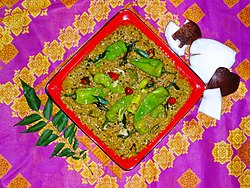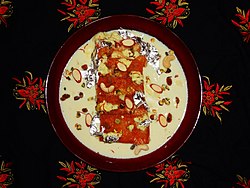Hyderabadi cuisine
This article possibly contains original research. (June 2016) |
| This article is part of the series on |
| Indian cuisine |
|---|
 |
|
| Part of a series on the |
| Culture of India |
|---|
 |
| Society |
| Arts and literature |
| Others |
| Symbols |
|
| Organizations |
|
|
Hyderabadi cuisine (native: Hyderabadi Ghizaayat), also known as Deccani cuisine, is the native cooking style of the Hyderabadi Muslims. The haute cuisine of Hyderabad began to develop after the foundation of the Bahmani Sultanate, and the Qutb Shahi dynasty centered in the city of Hyderabad promoted the native cuisine along with their own. Hyderabadi cuisine had become a princely legacy of the Nizams of Hyderabad as it began to further develop under their patronage.
The Hyderabadi cuisine is an amalgamation of Mughal, Turkish, and Arabic along with the influence of the native Telugu and Marathwada cuisines. Hyderabadi cuisine comprises a broad repertoire of rice, wheat and meat dishes and the skilled use of various spices, herbs and natural edibles.[1]: 3 [2]: 14 [3]
Hyderabadi cuisine has different recipes for different events, and hence is categorized accordingly, from banquet food, for weddings and parties, festival foods, and travel foods. The category to which the recipe belongs itself speaks of different things like the time required to prepare the food, the shelf life of the prepared item, etc.[4]
History[]
Medieval period[]
The Deccan region is an inland area in India. The native cuisine was prominent until the Vijayanagara Empire lasted, it was during the rule of Delhi Sultanate, Muhammad bin Tughluq when he shifted the capital from Delhi to Daulatabad, the Deccan region adopted the foreign cuisines. In the 14th century when the Bahmani Sultanate was formed by revolting against the Delhi Sultanate in Deccan, the Turkish noblemen were appointed in the high positions, and introduced the Turkish cuisine.
The two-centuries-long political instability in the region of the Deccan and the main Central Mughal authority and migration has introduced Deccan with multiple foreign cuisines.[5]: 91–92 [6]: 31
In Deccan medieval cuisine, banquets were common among the aristocracy. Multiple courses would be prepared and served in a style called Dastarkhān (A long cloth laid on the floor on which food dishes and dinners plates are placed). Food was generally eaten by hand, served on among commons and nobility. The food was mostly meat oriented being grilled and fried in tandoor. The curry were highly seasoned and flavored by using spices. Fruits were preferred rather than dessert after main course. Once the meals are ended Kahwa (liquid hot drink) was consumed that contains ingredients to digest food. The ingredients of the cuisine varied greatly according to the seasons and festivals, and many items were preserved in the form of Pickles.[5]: 91–92 [6]: 31 [7]
Modern period[]
The modern cuisine was evolved during the Nizams in the mid-17th century, and elevated to a sublime art form. Hyderabad has a history of continuous influx of migrants from all over the world and in general from the Indian sub-continent, particularly since 1857. Most of the foreign food had been improved to suit the culinary preferences, resulting to form the unique derivative cuisine that excels over the original. Biryani (Turkish) and Haleem (Arabic) for instance is prepared all over India, but the Hyderabadi variety is ultimately from the Hyderabadi Biryani and Hyderabadi Haleem. Til ke chatuni with Arabic tahini, Persian dried lamb with beans is modified with dalcha, tandoori naan of Uzbek (Central Asia) to create Sheermal. Most of the modern day desserts in Hyderabadi cuisine were introduced and invented during the times of Nizams, today that had become an integral part of cuisine.[6]: 31 [7]
Hyderabadi cuisine is an integral part of the cuisines of the former Hyderabad State that includes the state of Telangana and the regions of Marathwada (now in Maharashtra) and (now in Karnataka). The Hyderabadi cuisine contains city-specific specialties like Hyderabad (Hyderabadi biryani and Hyderabadi Haleem) and Aurangabad (Naan Qalia), Parbhani (), Bidar (Kalyani Biryani) and others. The use of dry coconut, tamarind, and red chillies along with other spices are the main ingredients that make Hyderabadi cuisine different from the North Indian cuisine.[6]: 31 [7]
Course[]
Hyderabadi dinner also known as Dastarkhwan are usually of five course meal; Aghaz (Soup), Mezban (appetizers), Waqfa (Sorbet), Mashgool Dastarkhwan (Main course) and Zauq-e-shahi (dessert).[8]
Starters[]
Lukhmi[]
Lukhmi is a regional non-vegetarian variation of the samosa, though, it is shaped into a flat square patty. It is made from flour and stuffed with minced mutton or beef, known as Kheema. It is eaten as an evening snack or served as a starter at celebrations.[9][10]
Murtabak[]
Murtabak is often described as spicy folded omelette pancake with bits of vegetables. It is the most common form of Murtabak; which is egg-filled pancake, sometimes mixed with green onion and minced meat, made from pan fried crepes which is folded and cut to squares.[11]
Hyderabadi Haleem[]
Hyderabadi Haleem is a popular dish of Hyderabad. It is a stew composed of mutton, lentils, spices and wheat.[12] It originates from Harees, an Arab dish brought to Hyderabad by Arab migrants. Harees is still prepared in its original form in Barkas.[13] It is sometimes served as a starter at celebrations, but it is usually only prepared during the month of Ramadan for the Iftar meal.[14]
Biryani[]

Hyderabadi Biryani is one of the most popular dishes of the city. It is distinctly different from other variations of the Biryani, originating from the kitchens of the Nizams of Hyderabad. It is a celebration dish of basmati rice and mutton, along with yoghurt, onions and various spices.[15][16][17]
Variants[]
- Kalyani Biryani is a variant of the Hyderabadi Biryani using beef instead of lamb or mutton.[18][19] This meal was started after Kalyani Nawabs of Bidar came to Hyderabad sometime in the 18th century. The Kalyani biryani is made with small cubes of beef, regular spices, onions and many tomatoes. It has a distinct tomato, jeera (cumin), dhania (coriander) flavour.[20]
- , made by the Hyderabadi Muslims is a rice and meat dish. Unlike biryani in which rice is precooked and then layered with meat, rice in tahari is cooked in meat. Occasionally vegetables, more commonly potatoes, are also added. It is served with dahi ki chutney.[21][better source needed]
Other dishes[]
Pathar-ka-Gosht[]
Pathar ka Gosht is a mutton kebab. It is named for the traditional method of preparation, on a stone slab. (Pathar means stone in Urdu as well Hindi)[22]
Hyderabadi Khichdi[]
The Hyderabadi version of the popular dish Khichdi is distinct from the many variants enjoyed all across India. It is eaten with Kheema (minced mutton curry). It is consumed as a breakfast item, as well as during the month of Ramadan for the Sehri meal.
While most khichdi preparations use toor or moong dal, the Hyderabadi version uses masoor dal. Also, turmeric doesn’t feature in the ingredients list although some people use it in the modern preparations. The colouring of the dish comes from the caramelized onions that are an important flavour of the dish. As opposed to the semi-liquid, moist preparation of khichdi elsewhere in the country, the dish made here has a drier texture, and each grain of rice stands out.
— Nawab Mehboob Alam Khan, culinary expert[23]
Talawa Gosht[]
Tala hua Gosht, or Talawa Gosht (in Hyderabadi dialect) is a simple mutton or beef[24] dish usually accompanied by Khatti Dal. It may be eaten with Roti or rice.[25]
Desserts[]
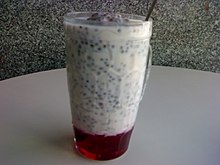
- Qubani ka meetha (Khubani-ka-Meetha) - Apricot Pudding, Toppings with almond and cream. The original recipe is a translucent liquid.
- Double ka meetha- Bread Pudding topped with dry fruits, a derivative of mughlai dessert Shahi tukre.
- Sheer korma - Vermicelli pudding and celebratory dessert, specially made on the Ramzan (EId Ul Fitr) day.
- Firni - A Rice dessert.
- Gil-e-Firdaus - A variant of Kheer made of bottle gourd. The name literally translates into "the clay of paradise".[26]
- Faluda - A dessert made of shredded vermicelli noodles with rose syrup and milk.
- Aab ka shola (Aab shola) - Typical Hyderabadi summer sharbat.[27]
- Hyderabadi Irani tea available at Irani cafes, served with Osmania Biscuits.[28]
Breads[]
Images[]

Hyderabadi Haleem.
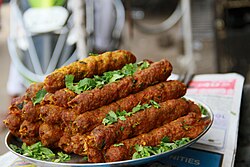
Seekh Kebab

Shami Kebab
Hyderabadi Biryani along with "Mirchi ka Salan"
Hyderabadi Chicken Biryani.
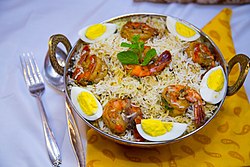
Prawn Biryani
Mirchi ka salan- a curry
Baghaar-e-baingan- a curry
Bagara khana and Dalcha.
Rice along with Khatti Dal and Pickle- a regular meal
Hyderabadi Tamatar Ka Kat-(Curry made of Tomato Soup).

Qubani-ka-Meetha-a dessert.
Double Ka Meetha-a dessert
References[]
- ^ Kapoor, Sanjeev (2008). Royal Hyderabadi Cooking. Popular Prakashan. ISBN 978-81-7991-373-4. Retrieved 19 September 2011.
- ^ Leonard, Karen Isaksen (2007). Locating home: India's Hyderabadis abroad. stanford university press. ISBN 978-0-8047-5442-2. Retrieved 19 September 2011.
- ^ Sen, Colleen Taylor (2004). Food Culture in India. Greenwood Publishing Group. p. 115. ISBN 9780313324871. Retrieved 8 March 2021.
- ^ "'Most Hyderabadi cuisine is dying' - The Times of India". The Times Of India.
- ^ a b Collingham, Lizzie (2006). Curry: A Tale of Cooks and Conquerors. Oxford University Press. ISBN 9780199883813. Retrieved 28 April 2013.
- ^ a b c d Chapman, Pat (2009). India food and cooking: the ultimate book on Indian cuisine. New Holland Publishers. ISBN 9781845376192. Retrieved 28 April 2013.
- ^ a b c Shahid, Sajjad (16 August 2011). "Biryani, Haleem & more on Hyderabad's menu". The Times of India. Archived from the original on 6 November 2012. Retrieved 28 April 2013.
- ^ "Day 2 in Hyderabad: Ivanka visits historic Golconda Fort". 29 November 2017. Retrieved 21 December 2017.
- ^ bgbag. "Badiya biryani". The Hindu. Retrieved 29 July 2018.[dead link]
- ^ "Lukhmi, the mince stuffed Hyderabadi savoury". The New Indian Express. Retrieved 29 July 2018.
- ^ "A rich medley of Nawabi flavours". 9 March 2014.
- ^ "On the food trail in Hyderabad, where Ramzan is incomplete without haleem". The News Minute. 6 June 2018. Retrieved 29 July 2018.
- ^ "It's haleem time". The New Indian Express. Retrieved 29 July 2018.
- ^ Alluri, Aparna. "Hyderabad's Charm Found in Ramadan Delights". India Ink. Retrieved 29 July 2018.
- ^ Khan, Sarah. "36 Hours in Hyderabad, India". Retrieved 29 July 2018.
- ^ Tankha, Madhur (2 August 2017). "The art of Hyderabadi biryani". The Hindu. ISSN 0971-751X. Retrieved 29 July 2018.
- ^ "9 kinds of biryani every food lover must know". BombayTimes. Retrieved 29 July 2018.
- ^ "The Other Hyderabadi Biryani With a 300-Year-Old Past".
- ^ Nanisetti, Serish (4 November 2015). "A tale of two biryanis". The Hindu. ISSN 0971-751X. Retrieved 29 July 2018.
- ^ "Why Kalyani Beef Biryani Is A Favourite Of Many Hyderabadis, Muslim And Hindu".
- ^ "MUTTON TAHARI RECIPE HYDERABADI". Yummy Indian Kitchen. 16 April 2015.
- ^ "Pathar ka gosht: A vanishing delicacy". 10 July 2014.
- ^ "One pot wonder!". 12 November 2017.
- ^ Reddy, Gautham; Shams, Alex (21 November 2016). "Welcome to the Beef Capital of India". Slate. ISSN 1091-2339. Retrieved 15 August 2018.
- ^ KhanaPakana.Com. "Hyderabadi Tala Hua Gosht - SnowWhite". www.khanapakana.com. Retrieved 29 July 2018.
- ^ "All's in a name! - Times of India". The Times of India. Retrieved 29 July 2018.
- ^ "Aab shola refreshing summer drink".
- ^ "Quintessentially Hyderabadi—Irani Tea". Retrieved 23 September 2016.
Further reading[]
- A Princely Legacy, Hyderabadi Cuisine By Pratibha Karan ISBN 81-7223-318-3, ISBN 978-81-7223-318-1 [1]
- Elegant East Indian and Hyderabadi Cuisine By Asema Moosavi, Moosavi, Asema ISBN 0-9699523-0-9
- The Essential Andhra Cookbook with Hyderabadi & Telengna Specialities by Bilkees I Latif
- 101 Easy to Cook Hyderabadi Recipes By Devi, Geeta [2]
- Food of India By Priya Wickramasinghe, Carol Selva Rajah
- You Are Where You Eat: Stories and Recipes from the Neighborhoods of New Orleans, By Elsa Hahne Page 47-50
- The Jewels of Nizam: Recipes from the Khansamas of Hyderabad By Geeta Devi, 2014, ISBN 9788129124364
- Aromas from a royal kitchen, 18 June 2019, The Deccan Herald
External links[]
| Wikimedia Commons has media related to Hyderabadi cuisine. |
- Hyderabadi cuisine
- Culture of Hyderabad, India
- Mughlai cuisine
- Telangana cuisine
- Indian cuisine by region
- Indian cuisine by city







